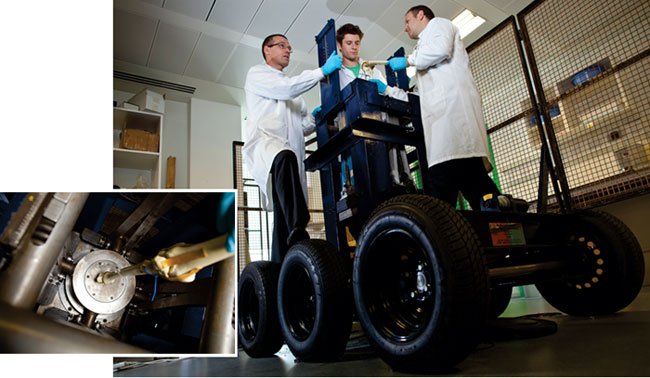From cells to limbs, UK center studies war injuries
DOI: 10.1063/PT.3.1433
A new center at Imperial College London works to understand injuries from explosions and to mitigate their damage. On 7 December the Royal British Legion announced it would put £5 million ($7.8 million) over five years into the new Centre for Blast Injury Studies; it is the first time that the charity, which looks after the interests of veterans, is investing in basic research. Imperial College is providing an additional £3 million, and the UK defense ministry is paying the salaries of participating military surgeons.
The center owes its start to serendipity, says director Anthony Bull, a bioengineer whose expertise is in sports injuries and degeneration of aging joints. A couple of years ago he began collaborating with two military trauma surgeons to look at blast injuries. When a bomb goes off under a vehicle, “there is a very high rate of deformation of the floor pan of the vehicle, which encroaches on the person who might be sitting or standing in the vehicle,” he explains. “The three of us very quickly realized there were things we could do.” They set out to understand the biomechanics and physics of loading effects on the human body. Around the same time, Imperial College scientists set up the Institute of Shock Physics, and some of its physicists are collaborating with the blast injury center. “We found the right people at the right time,” Bull says.
Academic–military alliance
Trauma and orthopedics professor Colonel Jon Clasper, a center cofounder, noted at the center’s launch that “as a result of advances in medical care, we now have a much greater survival rate than we ever did in previous conflict.” That means, he continued, “we have survivors with far more horrific and severe injuries than ever survived before, and it’s now becoming clear that there needs to be a better understanding of the basic science, the fundamental mechanisms, of these injuries, with a view to preventing them in the future or to improving treatment of them.”
The embedding of military researchers in an academic setting gives the center access to clinical records on injuries sustained in the wars in Iraq and Afghanistan. “This is highly unusual and rather important,” says Bull. In addition, the UK’s National Health Service allows for long-term follow-up studies. Research at the center will cover the effects of solid and gas explosions and how to minimize physical and biological damage at the cellular, tissue, organ, and body levels.
Research is a blast
The center’s signature apparatus is the anti-vehicle, underbelly, blast-injury simulator (AnUBIS), a one-of-a-kind simulator of roadside-bomb effects on car occupants. AnUBIS—the Greek name for an ancient Egyptian god of the dead—uses air to pressurize a 45-kg metal plate. When a shear pin fails, the plate shoots up, reaching a peak velocity of up to 25 m/s in 2 ms. The impact characteristics are controlled by varying the diameter and material of the pin. Bull says that 9 m/s “is sufficient to reproduce the battlefield injuries we see.” The researchers characterize the deformation and failure of materials or the damage to cadaver limbs or tissue hit by the metal. AnUBIS is used to validate numerical models and to test mitigation approaches, such as floor coverings, foot coverings, and posture.
Certain injuries are more debilitating than others. Heel injuries, for example, may show only external bruising, says Bull. But many individuals with heel injuries have elective amputations years later, after multiple operations. In contrast, a severe injury to the femur or shin “with lots of bone damage and maybe an open wound,” may be treatable, he says. “So, let’s deflect the energy of a blast to a region of the body that is more amenable to reconstruction.” Deflection can be achieved, he says, by varying the boot material, the heel geometry, the lacing, and the restraint at the top of the boot. “All of those combine to change how the energy is transmitted up the leg.”
At the cellular level, high-energy trauma can cause bone to form inside muscles. “It is highly painful and causes massive functional deficit,” says Bull, “so even if you salvage the limb, if you end up with this biological response, which is physically driven, you are in severe trouble.” At the center, researchers apply blasts to musculoskeletal stem cells. The aim is to first figure out how and why bone forms in the wrong places, and then to develop pharmacological intervention. Another area of cellular-level research will be blast lung, in which the shock of an explosion damages the lungs, often causing death.
War has historically led to advances in understanding anatomy and in treating trauma. And with the pullout from Afghanistan expected in a couple of years, Bull says, “If we are going to learn from this and perhaps implement some change, we need to do it rather quickly. And we need to be in the position to capture, analyze, and use all the clinical data and follow-up data now for posterity.”

The anti-vehicle, underbelly, blast- injury simulator, or AnUBIS, is used for laboratory studies of the impact of roadside blasts. Anthony Bull (left), director of the new Royal British Legion Centre for Blast Injury Studies at Imperial College London is standing on the rig with student Nic Newell (center) and research fellow Lieutenant Commander Tim Bonner. The inset shows a bone model mounted on AnUBIS and the metal plate that will rush up when a shear pin fails under pressure.
MARTIN BEDDALL AND IMPERIAL COLLEGE LONDON

More about the Authors
Toni Feder. tfeder@aip.org
